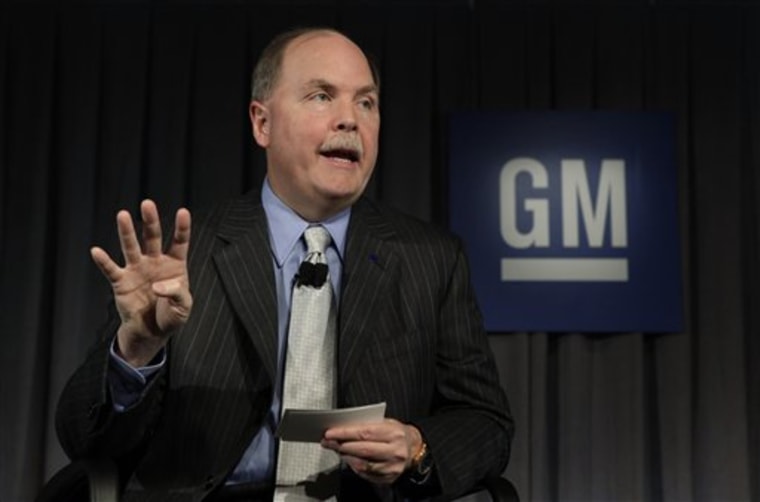General Motors, once the colossus of American capitalism, will become a leaner, government-owned company if the Obama administration goes along with the automaker's plan to slash jobs, close plants and eliminate the legendary Pontiac brand.
As GM laid out the proposal Monday, new agreements fell into place between Chrysler and its unions in the United States and Canada, making it apparent that the future of both companies now rests with their creditors.
General Motors CEO Fritz Henderson said the company would offer the Treasury Department more than 50 percent of its stock to absolve GM of $10 billion in government loans.
The automaker also proposed that the United Auto Workers take GM stock for at least half the $20 billion the company owes to a union-run trust that will assume retiree health care expenses starting next year.
Combined, the union and government would own 89 percent of the century-old automaker, which has been bleeding red ink and is saddled with more than $62 billion in debt.
"It is unprecedented, but it signifies the importance of the automobile industry," said David Lewis, a retired professor at the University of Michigan.
Although the government has loaned money to corporations in the past, including to Chrysler in the 1970s, Lewis could not recall a time when it had taken a majority stake in a company.
White House press secretary Robert Gibbs said the administration does not want to own GM or any other auto company.
"This administration has no desire to run an auto company on a day-to-day basis," Gibbs said. "We strongly back an auto industry we believe can, and should, be self-reliant of government funding."
But GM's plan depends on persuading unsecured bondholders who have loaned GM $27 billion to forgive that debt in exchange for a 10 percent stake in the company.
Current GM shareholders would own only about 1 percent.
GM's announcement sent its shares up 21 percent to $2.04 Monday, meaning bondholders would get about 46 cents on the dollar. But that does not take into account dilution of GM's shares once the government and the union get their giant piece of the pie.
Analysts estimated that the value was closer to 5 cents on the dollar.
General Motors is surviving on $15.4 billion in government loans, and said Monday in a filing with the U.S. Securities and Exchange Commission that it envisions getting an additional $11.6 billion.
GM Chief Financial Officer Ray Young said that's all the company will need under its new plan.
But if GM's restructuring plan cannot put all the pieces in place by June 1, the struggling company could go into bankruptcy protection.
Meanwhile, Chrysler is surviving only because of $4 billion in government aid. The company has until Thursday to adopt a partnership with Italy's Fiat Group SpA and to devise a restructuring plan that satisfies the government so it can get an additional $6 billion.
Just hours before GM gave its progress report, Chrysler announced it had a tentative concession agreement with the UAW that had been blessed by the government.
The Chrysler deal almost certainly will be the template for GM, although Young said negotiations with the union had not yet resumed in earnest. In addition, both companies have deals with the Canadian Auto Workers.
If successful, the plan for the government to own a majority of GM's outstanding common shares would wipe out $44 billion of GM's $62.4 billion debt. Bondholders have until May 26 to accept the offer, which is contingent on the deals with the government and the UAW falling into place.
Young said the Treasury Department always expected some of the government debt to be exchanged for GM stock, but the government issued a statement saying it had not decided to do it.
The company still prefers restructuring outside of court, but Henderson acknowledged bankruptcy is more likely now than a few weeks ago.
"The task at hand in terms of what we need to get done is formidable," Henderson said. "But it can be done."
GM said it would speed up six factory closings announced in February and close three additional facilities in 2010. Henderson expects to identify the plants in May and said they will include assembly, engine, transmission and parts-stamping factories.
GM will also cut 21,000 hourly jobs in the U.S. by 2010 — 7,000 more than what the company outlined just two months ago.
With the factory cuts, GM will be a mere fraction of its old self. At the end of 1991, the company had 304,000 hourly workers in the U.S.; by the end of 2010, it would have 40,000.
Also, General Motors Canada said it plans to slash its hourly work force from 10,300 to 4,400 by 2014. Young said the reduction follows previously announced plant closures.
In addition, GM plans to cut additional U.S. salaried jobs beyond the 3,400 cuts completed last week, and it plans to reduce dealerships 42 percent by 2010.
Mark LaNeve, vice president of North American sales, said many of the 450 dealers to be cut would be dropped with the elimination or sale of the Saturn, Hummer and Saab brands by the end of this year.
GM also said it will end its storied Pontiac brand no later than next year, killing a brand known for muscle cars such as the Trans Am and the GTO.
